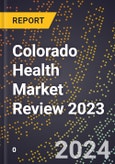28 Denver-Area Hospitals Reported Combined Pre-Tax Net Income in 2022 of $606.4 Million, or 4.4% of Net Patient Revenues of $12.46 Billion
After posting strong net income in 2021, Colorado HMOs and hospital systems saw their profits decline sharply in 2022. The decision by the owners of Centura Health to dissolve their joint venture and the entrance of Intermountain Health and its Select Health insurance division to the state may stimulate beneficial competition in both markets.
Key findings in the new report:
After posting record profits in 2021, net income for Denver-area hospitals dropped by 74% in 2022.
Based on financial data from Medicare cost reports, 28 Denver-area hospitals reported combined pre-tax net income in 2022 of $606.4 million, or 4.4% of net patient revenues of $12.46 billion. That was down from net income of $2.325 billion in 2021, which set new records, and $1.34 billion in 2020. In 2022, these hospitals had an operating income of $340.4 million and other revenues from government grants (including Provider Relief Funds), philanthropy, and investments of $1.351 billion, offset by significant other expenses.
HealthOne/HCA hospitals were the most profitable, with pre-tax net income of $667.7 million or 23.7% of net patient revenues. UC Health hospitals in the Denver area and other parts of the state, now the largest health system in the state, reported a loss of $277.5 million in 2022, or 5.2% of net patient revenues. That was a huge downward swing from UC Health’s net income of $1.914 billion in 2021 or 38.6% of net patient revenues. Net income for the Centura Health hospitals fell from $290.1 million in 2021 to $180.1 million in 2022. Of the largest health systems outside the Denver Metro area - UC Health, Banner, and Centura - only Centura was profitable in 2022.
Hospital systems in Colorado have invested billions in new hospitals, replacement facilities, and free-standing emergency rooms and urgent care centers.
Most of the new construction is in suburban Denver and areas with above-average household income. In some cases, new hospitals or expansions are targeted to a single service line, such as the new centers for orthopedic and spine surgery constructed by UC Health and CommonSpirit Health (owner of the Penrose St. Francis hospitals) in the Colorado Springs area.
Investment losses at Kaiser Permanente drove down HMO profits in 2022.
Colorado HMOs had a combined underwriting income of $51.6 million in 2022, down from a net income of $273.8 in 2021 and $662.3 million in 2020. However, investment losses of $118.8 million for Kaiser Permanente wiped out those profits for the group. Kaiser Permanente had a net income of $378.4 million in 2020 and $58.7 million in 2021, with strong results in Medicare Advantage and individual plans. Anthem Blue Cross Blue Shield improved its net income from $131.4 million in 2021 to $144.9 million in 2022. In the first three quarters of 2023, Colorado HMOs had better results, with a net income of $77.5 million and an average margin of 1.5%.
Enrollment in Colorado health plans increased by 3.8% in 2022, reaching a new peak of 1.92 million members.
Enrollment grew by 10.4% in 2020 and 2.8% in 2021. The growth has come in Medicaid, Medicare Advantage, and individual plans. United Healthcare’s Colorado HMOs added 51,000 lives in 2022 and Colorado Access added more than 46,000. Kaiser Permanente lost 104,000 members since 2019. However, 2023 annual statements are likely to show a decline in total HMO enrollment since more than 400,000 Medicaid recipients were dropped from the program in 2023 after they were determined to be ineligible or failed to provide the required information.
Enrollment in Medicare Advantage plans, both HMO and PPO, grew steadily in the past five years, reaching nearly a half million beneficiaries in January 2023, or about half the Medicare beneficiaries in the state. There are three new Medicare HMOs in the state, but only one of them, Devoted Health Plan, has reached 1,500 members.
Table of Contents
1. Introduction
Companies Mentioned
- Anthem Blue Cross Blue Shield
- Banner Health
- Centura Health
- Colorado Access
- CommonSpirit Health
- HealthOne/HCA
- Kaiser Permanente
- UC Health
Methodology
The reports analyzing state health care markets are intended to be a resource to health care organizations facing a full range of challenges but also seeking to identify and benefit from opportunities that present themselves.
This report is presented in three main sections. The first part, Market Structure, describes the major health insurers and hospital systems in the state, showing recent entrants and the high-level of consolidation that has occurred in both the health plan and provider markets. Market Trends, the next section, presents our analysis of enrollment trends and financial results for the health insurers. The last section contains our analysis of financial and inpatient utilization data on the hospitals in the state.
The analysis of health plan companies is based on their annual and quarterly statements filed with the Department of Insurance, including forms prescribed by the National Association of Insurance Commissioners and supplemental reports required by the state. The publisher also uses Medicaid data from the Department of State Health Services and Medicare health plan and hospital data from the Centers for Medicare and Medicaid Services. The publisher has that data together with insights that they have gained in interviews with dozens of leaders in health care organizations in the state.

LOADING...








